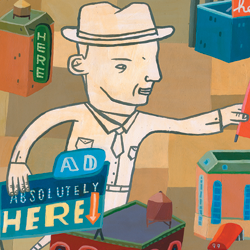 |
 Candy Adams,
Candy Adams,
CTSM, CME,
CEM, CMP, CMM,
"The Booth Mom,"
is an independent exhibit-management
consultant, trainer, speaker, writer, and an Exhibitor conference
faculty member.
CandyAdams
@BoothMom.com |
| |
 s exhibit managers, we don't always have the time or resources to make it to every show at which our company is exhibiting. The lucky few of us who have more than one person in our company's trade show department can send another member of our team to oversee the show on site. The rest of us usually have to entrust the task to someone from the sales or marketing departments who may not have ever attended a trade show, let alone managed an exhibit. s exhibit managers, we don't always have the time or resources to make it to every show at which our company is exhibiting. The lucky few of us who have more than one person in our company's trade show department can send another member of our team to oversee the show on site. The rest of us usually have to entrust the task to someone from the sales or marketing departments who may not have ever attended a trade show, let alone managed an exhibit.
Giving these stand-ins, whom I refer to as "booth captains," a crash course in exhibiting can be more time consuming and more stressful than actually going to the show ourselves. But many things that we take for granted about managing a show may not occur to the person or people who are managing the exhibit in our place. I've had my entire sales force just walk away and leave the exhibit at the end of a show, thinking, "Somebody else will take it down."
So to simplify and standardize training for my booth captains, I've developed a three-part approach. First, I compile and distribute a written show plan to any internal staffers and vendors involved in the show. Next, I host a pre-show meeting to walk through the plan and to verify that everyone involved knows what to expect during setup, show hours, and dismantle. Finally, I develop a survival guide for the person or team in charge of setup and dismantle.
This method has helped take some of the worry and hassle out of managing trade shows from afar. The following tips will help you apply this three-part approach to your own trade show program to guarantee effective exhibiting - even in your absence.
Show Plan
I create a show plan for every show I manage, whether I'm going to be there or not. But it is an especially crucial document if I'm not able to attend. The show plan includes all of the critical information about a specific show, from the date and location, to the show strategy, to the installation-and-dismantle schedules. I send it to the booth captain, as well as other vendors and internal staff who will be attending the show or involved with the planning.
In the show plan, I break the show information into the following seven categories:
1. Show - Contact information and major schedule items, including topics such as shipping, I&D, and pre-show meetings.
2. Strategy - Information about the show strategy, measurable objectives, target audience, and specific tactics.
3. Staff - Staff rosters, hotel and transportation arrangements, badges, and other logistical information.
4. Exhibit - A list of exhibit components, products to be displayed, collateral to be distributed, and in-booth services such as audiovisual, Internet, and lead-retrieval systems.
5. Shipping - A breakdown of what will be shipped, where it will be shipped, and at what time it will arrive at the show site.
6. Deadlines - A comprehensive list
of all show deadlines.
7. Other issues - Information on strategic, logistical, and housekeeping issues not addressed elsewhere.
After I receive the exhibitor manual for a show, I create the first draft of my show plan and distribute it to all internal staff who will be involved in managing or developing the strategy for the show. I distribute an updated version no less than 30 days prior to the show to all those attending, including internal staff and external vendors. Two weeks before the show, I distribute a
final show plan to everyone involved.
Pre-Show Meeting
To make sure that all internal and external stakeholders are on the same page prior to the show, I schedule a pre-show planning meeting at least a week before the show. I invite as many of these people as possible to attend in person and include the rest through teleconference. This call doesn't take more than 15 to 30 minutes, as we simply review the show plan and answer any questions the exhibit staff, vendors, and setup/dismantle team may have.
In this meeting, I review the pre-show and at-show schedules, setup and teardown procedures, and exhibit layout. I make sure all exhibit staff members know when and where to pick up their badges. I also distribute their housing information (such as their hotel arrival and departure dates and confirmation numbers), and inform everyone of transportation options to get them from the hotel to the show site and back.
Survival Guide
To help make sure that things run smoothly in my absence, I give the booth captain a detailed guide, which I call my survival guide. The survival guide consists of three primary components: setup information, at-show information, and dismantle information.
1. Setup Information
This section of the survival guide includes the following information:
 The name and address of the show venue, including the hall name and booth number. The name and address of the show venue, including the hall name and booth number.
 The setup hours and whether labor has been ordered or staff is expected to set up the exhibit. This is also the place to explain restrictions on what exhibit staff can do themselves based on local union jurisdiction. The setup hours and whether labor has been ordered or staff is expected to set up the exhibit. This is also the place to explain restrictions on what exhibit staff can do themselves based on local union jurisdiction.
 The number of pieces of freight that are expected (e.g. three crates, two cases, one roll of carpet, and two rolls of carpet pad), along with the time it is supposed to be delivered, the name of your specialized shipping company, its 24/7 customer service or dispatch phone number, and the shipment's tracking number. The number of pieces of freight that are expected (e.g. three crates, two cases, one roll of carpet, and two rolls of carpet pad), along with the time it is supposed to be delivered, the name of your specialized shipping company, its 24/7 customer service or dispatch phone number, and the shipment's tracking number.
 Instructions on who to contact if freight isn't in the booth as expected (e.g. "contact the general service contractor's service desk to see if your truck has arrived, and then call your carrier if it hasn't"). Instructions on who to contact if freight isn't in the booth as expected (e.g. "contact the general service contractor's service desk to see if your truck has arrived, and then call your carrier if it hasn't").
 The exact time when all empty freight containers need to be off the show floor and sent to storage. The exact time when all empty freight containers need to be off the show floor and sent to storage.
 Copies of all show orders and confirmations. This is also where I identify any utilities (e.g. electrical, Internet, plumbing, water, telephone) that have been ordered and whether they need to be in place before the carpet is installed. Copies of all show orders and confirmations. This is also where I identify any utilities (e.g. electrical, Internet, plumbing, water, telephone) that have been ordered and whether they need to be in place before the carpet is installed.
 Exhibit photos or renderings showing how it should look when it's set up, including graphic placement. Exhibit photos or renderings showing how it should look when it's set up, including graphic placement.
 A reminder to save packing boxes and material and to pick up "empty" labels at the GSC's service desk to place on any empty boxes or crates that need to be stored during the show. A reminder to save packing boxes and material and to pick up "empty" labels at the GSC's service desk to place on any empty boxes or crates that need to be stored during the show.
 Any specialized tools required to set up your exhibit (if do-it-yourself setup Any specialized tools required to set up your exhibit (if do-it-yourself setup
is allowed by union jurisdiction rules).
 A list of collateral (company product literature) and the quantities sent to the show. Also indicate where any leftovers need to be shipped after the show. A list of collateral (company product literature) and the quantities sent to the show. Also indicate where any leftovers need to be shipped after the show.
 Setup drawings (an 8.5-by-11-inch version) and information explaining where the full-size setup drawings are located in the exhibit crates. Setup drawings (an 8.5-by-11-inch version) and information explaining where the full-size setup drawings are located in the exhibit crates.
 Instructions regarding where and when to pick up any rented lead-retrieval systems and a reminder to lock them up nightly. Instructions regarding where and when to pick up any rented lead-retrieval systems and a reminder to lock them up nightly.
2. At-Show Information
The at-show section of my survival guide reiterates information from the show plan on the company's official show attire (aka booth uniforms), along with information about the company's "boothmanship" policy (e.g. no food or drink in the booth, no cell phones, no checking e-mail or PDAs during booth duty, etc.).
I also include essential logistics information such as when and where staffers can pick up their exhibitor badges, and what time staffers need to report to the exhibit (at least a half hour before the show opens, and more if demo or display equipment needs to be set up).
Finally, I include an overview of the procedure for taking qualified leads accurately and completely. The booth captain is responsible for communicating this information to the rest of the staff at the on-site meeting.
3. Dismantle Information
The post-show section of the survival guide includes the following information:
 Whether an I&D contractor has been hired to take down and pack up the exhibit, or if it is the booth captain's responsibility. Whether an I&D contractor has been hired to take down and pack up the exhibit, or if it is the booth captain's responsibility.
 The time empty cartons, cases, and crates are expected to return
to the booth from storage. The time empty cartons, cases, and crates are expected to return
to the booth from storage.
 How to repack the exhibit correctly to minimize damage (such as how to pack pop-up graphic panels in plastic sleeves to avoid scratching). How to repack the exhibit correctly to minimize damage (such as how to pack pop-up graphic panels in plastic sleeves to avoid scratching).
 Instructions to remove all old labels from the shipping cases/cartons and place two labels on each carton. If different parts of the shipment are going to different locations (such as the exhibit house and your office), indicate which labels to use on which packages. Instructions to remove all old labels from the shipping cases/cartons and place two labels on each carton. If different parts of the shipment are going to different locations (such as the exhibit house and your office), indicate which labels to use on which packages.
 How to complete the outbound material-handling form (aka bill of lading) and where to turn it in. If my booth captain isn't experienced in managing the on-site logistics of trade shows, I often make a sample of this form (with filled-in blanks that he or she can simply duplicate on the copy received at the show) and include it in the survival guide. How to complete the outbound material-handling form (aka bill of lading) and where to turn it in. If my booth captain isn't experienced in managing the on-site logistics of trade shows, I often make a sample of this form (with filled-in blanks that he or she can simply duplicate on the copy received at the show) and include it in the survival guide.
 A reminder to let me know via phone or e-mail if there were any problems or if there was any damage to the exhibit or graphics that will need attention before being used again. A reminder to let me know via phone or e-mail if there were any problems or if there was any damage to the exhibit or graphics that will need attention before being used again.
 A reminder to return the lead-retrieval machine and secure the leads. Believe it or not, without prompting, some staff will just leave the lead machine in the booth space after the show without returning it to the rental vendor or downloading the leads. Also explain what they should do with the leads after the show (and how long they have to do it). A reminder to return the lead-retrieval machine and secure the leads. Believe it or not, without prompting, some staff will just leave the lead machine in the booth space after the show without returning it to the rental vendor or downloading the leads. Also explain what they should do with the leads after the show (and how long they have to do it).
 Last, don't forget to give your staff any necessary phone numbers, such as your cell-phone number and the 24/7 number of your specialized transportation carrier. But hopefully, because you will have done such a good job briefing them on all the info they need on site, everything will go smoothly and you'll never have to answer a single emergency phone call. e Last, don't forget to give your staff any necessary phone numbers, such as your cell-phone number and the 24/7 number of your specialized transportation carrier. But hopefully, because you will have done such a good job briefing them on all the info they need on site, everything will go smoothly and you'll never have to answer a single emergency phone call. e
|





 s exhibit managers, we don't always have the time or resources to make it to every show at which our company is exhibiting. The lucky few of us who have more than one person in our company's trade show department can send another member of our team to oversee the show on site. The rest of us usually have to entrust the task to someone from the sales or marketing departments who may not have ever attended a trade show, let alone managed an exhibit.
s exhibit managers, we don't always have the time or resources to make it to every show at which our company is exhibiting. The lucky few of us who have more than one person in our company's trade show department can send another member of our team to oversee the show on site. The rest of us usually have to entrust the task to someone from the sales or marketing departments who may not have ever attended a trade show, let alone managed an exhibit. 


